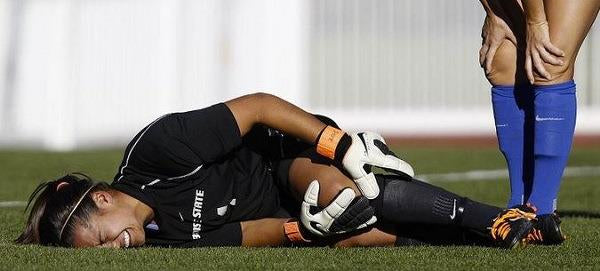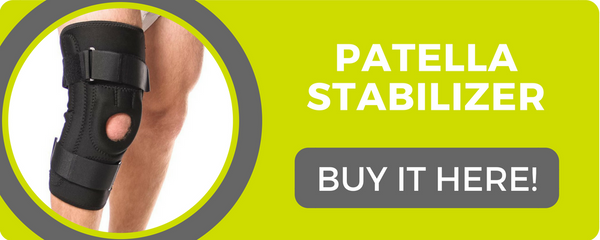Patellar Dislocation | Dislocated Knee Cap, Dislocated Patella, Treatment & More
What is Patellar Dislocation?
Patellar dislocation is the scientific name for a dislocated kneecap. A common mistake is to mix up patellar dislocation with knee dislocation, which are slightly different. A dislocated knee is much worse than a dislocated kneecap. When a dislocation of the knee happens your thigh and shin bones no longer connect. When the knee gets dislocated also ligaments in the knee also tear. Knee dislocations happen from high trauma impacts generally like getting hit by a car. When the patellar is dislocated there is less pain and less deformity.
Your patella (kneecap) is a triangle shaped bone held by tendons and stabilized by ligaments in a groove right between the femur (thigh bone) and tibia (shin bone). The groove the kneecap sits in is called the patellofemoral groove. When the kneecap shifts out of its spot in the patellofemoral groove it called a kneecap dislocation. A Partially dislocated kneecap is called a subluxation.
For a more in-depth explanation of the patella and the surrounding tendons and ligaments check out the article “Patellar Fractures”.

The kneecap’s main purpose is to coordinate knee extension and make sure the leg does not overextend. The kneecap starts out as a piece of cartilage and as a person gets older it transforms into bone.
Dislocated Kneecap Symptoms
Patellar dislocation has some telltale symptoms, which are as follows:
- Horizontal dislocation of the kneecap.
- Extreme Pain
- Swelling
- Leg will not straighten.
- Kneecap is loose and can be moved too easily from side to side.
Normally the kneecap will dislocate to the side or lateral of the kneecap. The kneecap may move back into place on its own when the leg is straightened. If a leg will not straighten and stays bent then a doctor will have to move the kneecap back. Here is a picture of what a dislocated kneecap looks like:

As one would guess a dislocated patella can cause a great deal of pain in the knee, especially initially before it is put back into place. Swelling is another common dislocated patella symptom and normally happens rapidly upon injury. Also when dislocated the kneecap can be moved side to side easily.
It is not uncommon for a tendon or ligament such as the medial patellofemoral ligament, MCL (medial collateral ligament), or LCL (lateral collateral ligament) to be damaged due to kneecap dislocation.
If the kneecap moves back of its own accord before a physician sees it then the physician may do a Patellar Apprehension Test to check the damage. An X-ray and possibly an MRI will be done on the knee to check for anything serious like a fracture or broken bone or cartilage fragments in the knee.
The symptoms of a dislocated knee are different than a patellar dislocation. When a knee is dislocated the symptoms generally include: extreme pain, swelling, discoloration, and sometimes numbness below the knee.
Dislocated Patella Causes and Risk Factors
Patellar dislocation is caused primarily by two incidences. First, it is most commonly associated with the twisting of the knee while keeping the foot planted firmly. This type of incident happens in sports where quick cuts are important such as soccer, basketball, skiing, and football.

Second, a dislocated kneecap can be the end product of a forceful direct blow to the knee. The blow can knock the kneecap from its groove effectively dislocating it. This could happen in a sport like football or soccer or just everyday life.
Some people are more likely than others to have a patellar dislocation. Studies show that women are more likely than men to dislocate their patella. Also, young people (around 10-20 years of age) are more likely than older people to have patellar dislocation happen. An imbalance of the knee joints can be a factor that leads to dislocation. Finally, if a person has already had a dislocated kneecap they are more likely to dislocate it again.
Patellar Dislocation Treatment
The first step to do for a patellar dislocation is to splint the knee and go to the hospital so they can give proper dislocated kneecap treatment.
The next step in kneecap dislocation treatment that must happen is to set the kneecap back into place. This may happen naturally if the leg can be straightened or a medical professional can easily move the kneecap back into place (this is the safer option).
Once the patella is back in its place, a doctor will most likely have it X-rayed and possibly have an MRI done on the knee. At this point, the doctor is looking for any fractures in the kneecap, any loose cartilage or bone fragments that could damage tendons and ligaments, or cartilage damage. After this step, there are two options for dislocated patella treatment.
If there is a fracture or fragments in the knee or the kneecap continually dislocates then patellar dislocation surgery is recommended. Kneecap dislocation surgery is an open surgery or arthroscopic and one can leave the same day. There a few different types of surgery that can be done in the case of patellar dislocation.
- Lateral Release- For this surgery, the ligament on the outside of the knee is cut and then loosened. Doing so relieves tension pulling the kneecap to the outside.
- Medical Imbrication- This is the opposite of Lateral Release. With this patellar dislocation surgery, the pull of the kneecap (which is less than the pull to the outside) is tightened. Tightening the muscles on the anterior side of the knee can do this.
- MPFL Reconstruction- This is a modern surgery in which the surgeon reconstructs the MPFL (medial patellofemoral ligament) or attaches a completely new one to the kneecap.
- Bone Realignment- This surgery has to do with fixing abnormal bone structure or ligament structure in an individual’s knee.
You can find an animation of MPFL Reconstruction and how it is done.
If there is no damage to the cartilage or bone or the knee feels stable than the leg will be put in a cast for a few weeks. After the cast is removed the person will go to physical therapy to rehabilitate the knee’s strength and its stability. During this time a brace can be helpful to stabilize the knee. Bracebility has a number of good braces for patellar dislocation and knee stabilization. Dislocated kneecap recovery can take anywhere from six to sixteen weeks depending on how quickly it heals and the severity of knee damage. When a patella is dislocated recovery is normally led by a physical therapist. The PT will help strengthen the muscles around the kneecap to get you moving again and at full health.
Patellar Dislocation Prevention
Even after treatment for a dislocated kneecap, someone who has dislocated a kneecap once is more likely to do so again. The more a kneecap dislocates the more likely one is to get knee arthritis. To prevent a dislocated kneecap from happening or repeating a good strategy is to strengthen the leg muscles particularly the quadriceps. A good knee brace may help to stabilize the kneecap during sports or just daily activities. Knee braces or sleeves can help the knee recover and keep it from getting injured again while the kneecap is healing. Some sleeves help with blood flow to the knee and can help reduce swelling. Besides patellar dislocation braces, Braceability also carries great subluxation braces.
One of our most popular patellar dislocation braces is the Patella Stabilizer Knee Brace. The Patella Stabilizer is great for stabilizing the knee with its rigid build while allowing the knee to breathe and stay cool. It is the best knee brace for helping the knee heal from a patellar dislocation.





